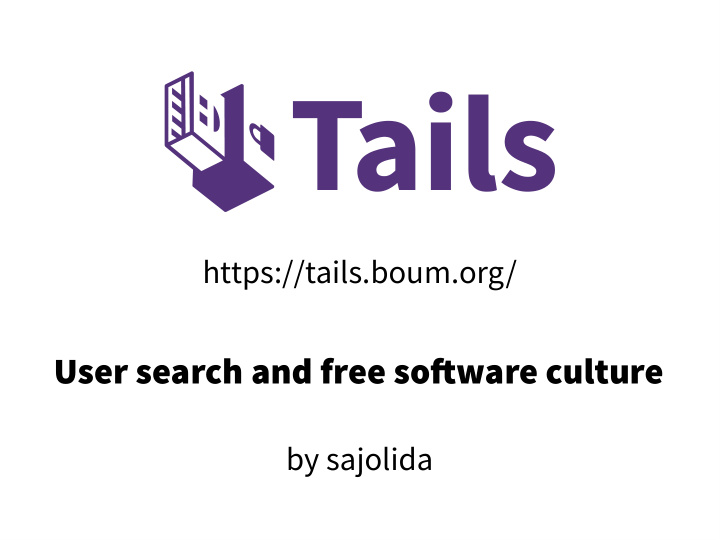



https://tails.boum.org/ User search and free sofuware culture by sajolida
1. What is Tails 2. Our usability process 3. User research and free sofuware culture
Tails Tails is a portable operating system that protects your privacy and avoids censorship.
Tails ● Free sofuware Linux, based on Debian, Tor, and GNOME ● Portable Leaves no trace on the computer ● Anonymity and censorship circumvention All network trafgic goes through Tor ● Privacy toolbox Includes many tools, security by default
Who uses Tails ● Journalists Edward Snowden: « Todos los periodistas que reportarón las revelaciones sobre la vigilancia de masa en 2013 dependian de Tails. »
Who uses Tails ● Human-rights defenders – Journalists in Mexico use Tails to investigate human- right violations by companies. – NDI (National Democratic Institute) used Tails to create a data collection system during elections in Belarus. – The Operational Security Professional's Association works with shelters to integrate Tails in their security plan for domestic violence survivors
Our usability process
Step 0: What to build?
Step 1: Paper prototyping ● Always test the design before writing any code! ● Rapid prototyping tool ( WireframeSketcher )
Step 1: Paper prototyping ● Faster: – Avoid throwing code away – Avoid debates – Avoid specifications & deliverables ● Better: – Avoid designing the impossible – Make the most of what's possible ● Stronger: – Developers really want to fix the problems ● Carolyn Snyder, Paper Prototyping (2003)
Step 2: Code
Step 3: Moderated user testing ● 5 users ● Record! – Screencast: Kazam – External camera: VLC ● Steve Krug, Don’t make me think , Chapter 9
Step 4: Prioritize the problems
Step 5: Fix
User research and free sofuware culture
Bug reporting culture ● We wait for people to tell us their problems instead of actively looking for them – We miss many smaller problems – We can only guess how bad the problems are – We lack empathy
Vocal minority ● 23 000 daily users → ~ 150 000 users if weekly ● 32 active users on our bug tracker in 2018 ● 1/5000 ● Matthew Paul Thomas (2008): « Si no se hacen pruebas de usabilidad frecuentemente, los proyectos dependen de retornos subjetivos por parte de pocas personas muy motivadas. Pero lo que dicen estas personas no es necesariamente representativo del conjunto de usuarias, ni tanto solo de su propio uso. »
Silent majority ● WhisperBack : integrated error reporting tool ● ~ 500 users in 2018 ● 1/300 (× 15) ● David Nichols and Michael Twidale (2003): « […] Reportes de incidencias integrados son muy buenos para resolver problemas de usabilidad en proyectos de codigo abierto. Es decir, hacer que los usuarios reporten sus problemas al momento de tenerlos durante el uso de una applicación. »
Patches are (not always) welcome ● Havoc Pennington, Free sofuware and UI (2002) « Se le puede dar al usuario literalmente una infinidad de opciones. Pero cada una tiene un coste de usabilidad. Entonces un programa con opciones infinitas es infinitamente malo. El trabajo del diseñador es seleccionar cuales opciones son realmente utiles. » ● Hard to say no. Even harder to remove a feature.
Root cause analysis Give me some painkiller! ● Five whys Sakichi Toyoda
Observe instead of listening ● Jakob Nielsen, 1st Rule: Don't Listen to Users https://www.nngroup.com/articles/first-rule-of-usability-dont-listen- to-users/ ● Behavioral (what people do) – User testing, paper prototyping, integrated error reports ● Attitudinal (what people say) – Interview, surveys, mailing lists, bug reports ● Christian Rohrer, When to Use Which User- Experience Research Methods https://www.nngroup.com/articles/which-ux-research-methods/
User research takeaways Don’t Do Write code, test afuerwards Test, then write code Listen to what people say Observe what people do Pay too much attention to the Find ways to learn about the vocal minority silent majority Fulfill requests Understand the root cause Say “yes” by default Learn how to say “no”
Litterature ● Havoc Pennington, Free sofuware and UI (2002) https://ometer.com/preferences.html ● David Nichols and Michael Twidale, The Usability of Open Source Sofuware (2003) http://firstmonday.org/ojs/index.php/fm/article/view/1018/939 ● Matthew Paul Thomas, Why Free Sofuware has poor usability, and how to improve it (2008) https://web.archive.org/web/20080805012124/http://mpt.net.nz:80 /archive/2008/08/01/free-sofuware-usability
Thank you! sajolida@pimienta.org https://un.poivron.org/~sajolida/unam.pdf
Recommend
More recommend